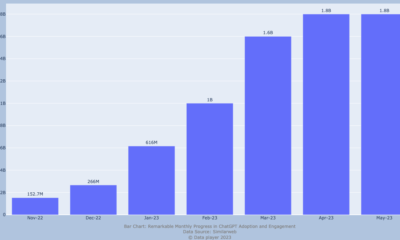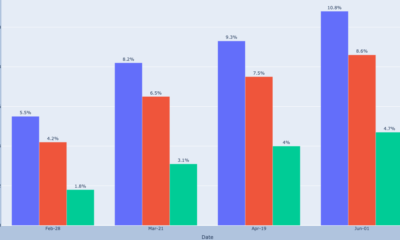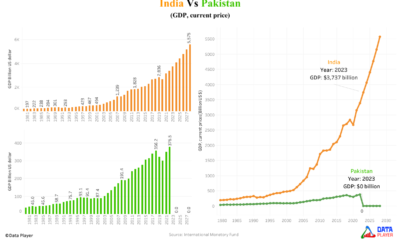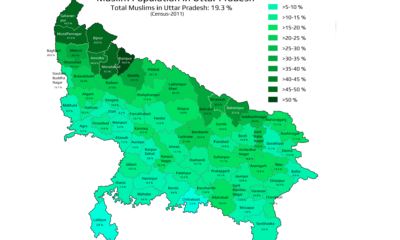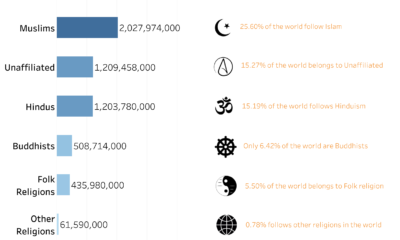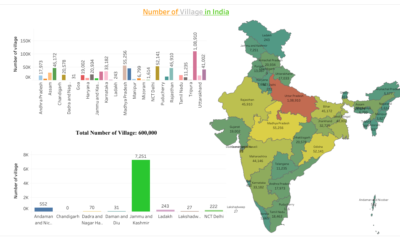
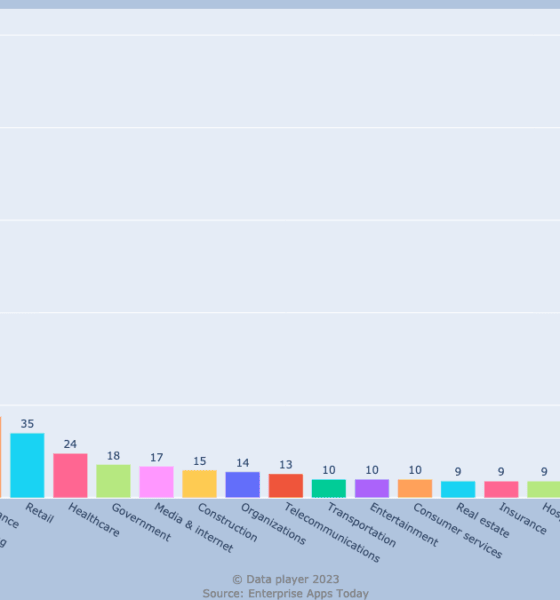
Technology
How many Industries are using ChatGPT
Published
2 years agoon
Introduction
In today’s digital world, many businesses are using advanced technologies to improve their operations and enhance customer experiences. One such technology is ChatGPT, a smart language model developed by OpenAI. Here, we’ll explore how various industries are using ChatGPT to make their work easier and provide better services to their customers.
The above bar chart shows the number of companies that are started using ChatGPT for their businesses. Thera are 23 sectors where ChatGPT has been used. Lets discuss each and every points.
- Technical (251 organizations): ChatGPT is widely used in the technical sector. Over 250 organizations are using it to automate tasks, provide technical support, and create user-friendly interfaces for complex systems. This helps them work more efficiently and deliver better products and services.
- Education (209 organizations): In the education sector, ChatGPT is transforming the way students learn and teachers teach. More than 200 organizations are using it to create interactive learning materials, answer student questions, and provide personalized tutoring. This makes learning more engaging and accessible for students.
- Business Services (98 organizations): Nearly 100 organizations in the business services industry are benefiting from ChatGPT. They use it for tasks like customer support, lead generation, and data analysis. By automating these processes, businesses can save time and improve their services.
- Manufacturing (89 organizations): In manufacturing, ChatGPT is helping companies streamline their operations. Around 90 organizations are using it to optimize production processes, manage supply chains, and gather real-time insights. This improves productivity and ensures better quality control.
- Finance (44 organizations): The finance industry is also utilizing ChatGPT. About 40 organizations are using it for tasks like financial analysis, risk assessment, and fraud detection. ChatGPT helps process large amounts of data and provides valuable insights for making financial decisions.
- Retail (35 organizations): ChatGPT is making a difference in the retail sector as well. Around 35 organizations are using it to engage customers, offer personalized recommendations, and manage inventory. This improves the overall shopping experience and helps businesses increase sales.
- Healthcare (24 organizations): In the healthcare industry, ChatGPT plays a vital role. With 24 organizations employing it, ChatGPT aids in patient engagement, symptom analysis, and appointment scheduling. It helps healthcare providers deliver timely and personalized care to patients.
- Government (18 organizations): Government agencies are also adopting ChatGPT, with 18 organizations using it for various purposes. ChatGPT assists in citizen services, policy analysis, and public communication. It enables governments to engage with their constituents effectively.
- Media & Internet (17 organizations): In the media and internet sector, ChatGPT has gained traction. Seventeen organizations utilize ChatGPT for content generation, automated reporting, and personalized recommendations. It helps media companies deliver engaging content and improve user experiences.
- Construction (15 organizations): ChatGPT is making an impact in the construction industry as well. Fifteen organizations employ ChatGPT for project management, cost estimation, and design assistance. It streamlines construction processes and enhances collaboration among teams.
- Organizations (14 organizations): Internal communication and knowledge sharing are improved through ChatGPT in various organizations. With 14 organizations utilizing ChatGPT, it facilitates information retrieval, task management, and collaboration among employees.
- Telecommunications (13 organizations): ChatGPT is utilized by 13 organizations in the telecommunications industry. It aids in customer support, network monitoring, and service troubleshooting. ChatGPT ensures smooth communication and resolves technical issues promptly.
- Transportation (10 organizations): The transportation sector benefits from ChatGPT in multiple ways. Ten organizations employ ChatGPT for route optimization, logistics planning, and customer service. It helps streamline operations and improve overall efficiency.
- Entertainment (10 organizations): ChatGPT is enhancing the entertainment industry as well. Ten organizations are utilizing ChatGPT for content recommendations, interactive storytelling, and personalized experiences. It allows entertainment companies to engage with their audience in innovative ways.
- Consumer Services (10 organizations): In the consumer services sector, ChatGPT is making a difference. Ten organizations use ChatGPT for customer support, product recommendations, and personalized assistance. It improves customer satisfaction and fosters long-term relationships.
- Real Estate (9 organizations): ChatGPT is transforming the real estate industry, with nine organizations leveraging its capabilities. It aids in property search, virtual tours, and answering customer inquiries. ChatGPT enables real estate agents to provide comprehensive information to potential buyers.
- Insurance (9 organizations): The insurance industry benefits from ChatGPT as well. Nine organizations use ChatGPT for policy recommendations, claims processing, and customer assistance. It helps insurance companies streamline their operations and deliver better services.
- Hospitality (9 organizations): ChatGPT is revolutionizing the hospitality sector, with nine organizations incorporating it into their processes. It assists in personalized guest experiences, concierge services, and reservation management. ChatGPT enhances customer satisfaction and helps hotels and resorts deliver exceptional service.
- Energy, Utilities & Waste Treatment (9 organizations): ChatGPT plays a role in the energy, utilities, and waste treatment sector. Nine organizations utilize ChatGPT for energy consumption analysis, waste management optimization, and customer engagement. It aids in making environmentally conscious decisions and improving resource utilization.
- Wholesale (6 organizations): In the wholesale industry, ChatGPT is proving to be valuable. Six organizations leverage ChatGPT for inventory management, order processing, and customer inquiries. It streamlines wholesale operations and improves customer service.
- Law Firms & Legal Services (1 organization): ChatGPT is making its way into law firms and legal services. One organization employs ChatGPT for legal research, document analysis, and client communication. It assists lawyers in their work and enhances efficiency.
- Cultural (1 organization): The cultural sector benefits from ChatGPT as well. One organization uses ChatGPT for art curation, historical analysis, and interactive exhibits. It enhances cultural experiences and promotes engagement.
- Agriculture (1 organization): ChatGPT has also found its place in the agriculture industry. One organization utilizes ChatGPT for crop management, weather analysis, and pest control. It assists farmers in making informed decisions and optimizing agricultural practices.
Conclusion
ChatGPT’s impact is evident across a wide range of industries. From technology to education, finance to retail, and healthcare to transportation, organizations are leveraging ChatGPT’s capabilities to streamline processes, enhance customer experiences, and drive innovation. As ChatGPT continues to advance, we can expect ChatGPT to play an even bigger role in shaping how businesses operate and serve their customers in the future.
Where does the Data fetch from?
Data Source: Data for ChatGPT uses by Industries:2023 is fetched from Statista and Enterprise Apps Today. Several other information are taken from personnel research.
You may like
Technology
Top Most-Visited Websites 2025 | What the World Was Searching?
Published
5 months agoon
July 28, 2025Excerpt: The latest June 2025 web traffic rankings reveal a clear dominance by U.S.-based tech giants, with Google’s services leading the pack. This analysis delves into the top 50 most-visited websites, highlights sector trends—especially the rise of adult content platforms—and offers comprehensive data insights through tables and charts.
Global Leaders in Online Traffic
Google Search retains its crown as the world’s most-visited site, followed closely by YouTube and Facebook. U.S. companies occupy eight of the top ten slots, underscoring their global reach and infrastructure advantages.
- Search Engines: Google.com (1st), Bing.com (23rd), DuckDuckGo.com (43rd)[1]
- Social Media: Facebook.com (3rd), Instagram.com (4th), X.com/Twitter.com (6th)[2]
- Video Platforms: YouTube.com (2nd), Twitch.tv (29th), Bilibili.com (25th)
Top Most-Visited Websites (June 2025)
Sector Breakdown
Analyzing the full data set of the top 50 sites reveals distribution across categories. Notably, adult content sites have climbed into prominence, reflecting changing consumption patterns.
Rise of Adult Content Platforms
Adult websites now account for six of the top 50, including Pornhub (17th), XVideos (27th), xHamster (30th), XNXX (41st), Eporner (49th), and Stripchat (45th). These platforms collectively draw hundreds of millions of daily visits, fueled by mobile accessibility and global bandwidth improvements.
- Regional Insights: Europe and North America remain the largest audiences, but Asia-Pacific shows the fastest growth.
- Regulatory Impact: Varying national regulations affect rankings; for instance, China’s restrictions elevate domestic sites like Bilibili (25th).
Complete Data Sets and Methodology
Our analysis leverages the complete data sets provided by Similarweb and Semrush for June 2025. Metrics include unique visitors, engagement time, and traffic sources. Combining both platforms ensures accuracy and cross-validation.
Regional Variations and Growth Prospects
Outside the U.S., Japan’s Yahoo.co.jp (10th) and China’s ByteDance-owned TikTok.com (13th) demonstrate regional dominance. Emerging markets in Latin America and Africa are increasingly represented by news portals (e.g., Globo.com at 37th) and e‑commerce (eBay.com at 47th).
- Latin America: MercadoLibre’s influence is rising, though not yet in the top 50.
- Africa: Upticks in local news and messaging apps signal future entries.
Key Takeaways
- U.S. Tech Supremacy: American companies maintain a stronghold on global web traffic.
- Adult Content Emergence: Six adult sites in the top 50 reflect shifting consumer behaviors and improved accessibility.
- Diverse Growth: News, marketplace, and software categories continue expanding regionally.
As internet usage evolves, these rankings will adjust, highlighting the importance of continuous monitoring of complete data sets for market insights and strategic decision-making.
References
- Similarweb.com. (2025). June 2025 Global Ranking. Available at: https://similarweb.com/global-june2025 [Accessed 24 Jul. 2025].
- Semrush.com. (2025). Website Analytics Report June 2025. Available at: https://semrush.com/reports/june2025 [Accessed 25 Jul. 2025].
Technology
These Are the 20 Most Hacked Passwords of 2024 – Are You Using One?
Published
5 months agoon
July 27, 2025Excerpt: Despite ongoing warnings about password hygiene, the latest NordPass analysis reveals that users persistently opt for shockingly weak credentials. Our deep dive into the Top 20 most common passwords uncovers alarming patterns and underscores the urgent need for stronger, individualized security measures.
Overview of the Top 20 Passwords
The NordPass dataset highlights which passwords are most prevalent globally, revealing that all 20 entries can be cracked in under one second. The concentration of simple numeric sequences dominates the list, reflecting a troubling reliance on easily guessable strings [3]
Top 20 Most Common Passwords (2025) – Time to Crack & Estimated Count
Key Insights from the Data
- Uniformly Fast Crack Times: Every password in the list takes less than one second to breach using standard brute-force tools.
- Numeric Dominance: Half of the top 20 are strictly number-based, underscoring the false sense of security users place in simple digit strings.
- Minimal Variations: Common patterns like “qwerty” and repeated digits appear repeatedly, showing a lack of creativity in user-generated passwords.
- Complete Data Sets: The NordPass report provides full visibility into all 20 passwords, enabling comprehensive analysis and targeted user education.
- Facts: About 78% of the most common passwords globally (including those in the US list) can be cracked in under 1 second.
Distribution of Password Popularity
Examining the estimated counts across the top 10 entries illustrates how a handful of passwords account for the majority of exposures. The following bar chart depicts the gradient from the most to the least common within this subset [4]
Categorical Breakdown of Password Types
To better understand user behavior, passwords can be grouped by composition. The chart below shows the proportion of numeric-only, alphabetic, keyboard-pattern, and mixed/phrase entries among the top 20.
Regional and Security Implications
While NordPass’s global dataset provides a broad overview, regional analyses often mirror these trends, with the majority of users favoring brevity and familiarity over complexity. Cybersecurity experts warn that such predictable selections dramatically increase vulnerability to credential-stuffing attacks, particularly as automated tools improve in speed and sophistication.
- Awareness Campaigns: Educating users on the dangers of reuse and encouraging passphrases can mitigate risk.
- Multi-Factor Authentication: Implementing additional verification steps adds a critical layer of defense.
- Password Managers: Leveraging tools that generate and store unique passwords reduces human error.
A strong password is your first line of defense against hackers. According to NordPass’s 2024 report, millions of people still use weak passwords like “123456”, “password”, and “123456789”—all of which can be cracked in less than one second using automated tools. Shockingly, over 3 million accounts used “123456” alone. These passwords offer no real protection and are often the first combinations tested in cyberattacks.
NordPass Most Common Passwords by Country (2024)
- United States: The most common password is secret, used by over 328,000 people. While unique compared to global trends, it remains easily crackable in under 1 second.
- India: 123456 is the top choice with 363,000+ estimated uses. Its simplicity makes it highly vulnerable, cracked instantly despite India’s large digital population.
- United Kingdom: qwerty123 dominates with ~300,000 estimated uses. Though slightly more complex than 123456, it is still cracked in less than 1 second.
- Canada, Netherlands, Finland, Norway, and Lithuania also share qwerty123 as the top password, with combined usage exceeding 1.25 million. This cross-country trend suggests a regional reliance on keyboard-patterned passwords.
- Spain, Italy, Brazil, Argentina, Mexico, South Africa, and New Zealand all have 123456 as the most used password, with combined usage exceeding 1.9 million. This reflects a global reliance on ultra-simple numeric patterns.
- Germany’s top password passwort (the German word for “password”) is used by ~275,000 users, reflecting a language-based but still weak approach.
- France favors doudou (a term of endearment), indicating cultural personalization, but it’s still cracked instantly.
- Russia’s 1q2w3e and Poland’s zaq12wsx show regional keyboard patterns that offer marginal complexity but remain insecure.
- Ukraine stands out with PovlmLy727, appearing complex but still crackable instantly—likely due to predictable structure.
- Greece uses 212121 (repeating numbers), and Hungary uses long numeric strings like 63245009, both offering no real strength.
- Latvia, Estonia, and Denmark show attempts at mixing words and numbers (911yana777, D1lakiss, webhompass), though none survive even 1 second of cracking attempts.
- Iceland’s kassi (a common word) and Croatia’s dinamo (sports-related) reflect local vocabulary trends, but both lack complexity.
- Philippines has admin as its top password, a known default login credential—an alarming sign for personal and organizational security.
- Australia continues to use password, one of the oldest and weakest choices in password history, used by ~280,000 people.
- Over 90% of the top 200 passwords used in each country can be cracked in less than 1 second, showing widespread reliance on weak credentials.
- The United States has the longest maximum crack time at approximately 2 hours 20 minutes, with complex examples like P@ssw0rd!2023.
- The United Kingdom and Canada follow with maximum crack times exceeding 1 hour, indicating slightly stronger password habits.
- India’s longest crack time among its top 200 passwords is around 20 minutes, with examples like india@2023 and bharat#123. However, most Indian users still rely on simple numeric strings like 123456.
- Countries with the shortest maximum crack times include Croatia and the Philippines, where even the strongest common passwords are cracked in just 5 minutes.
- Stronger passwords typically include a mix of uppercase and lowercase letters, numbers, and special characters.
- Despite the presence of stronger passwords, the vast majority of users globally continue to use extremely weak ones, making accounts highly vulnerable.
- There is an urgent global need for better password practices, adoption of password managers, and the use of multi-factor authentication (MFA).
- Similarweb.com. (2025). June 2025 Global Ranking. Available at: https://similarweb.com/global-june2025 [Accessed 24 Jul. 2025].
- Semrush.com. (2025). Website Analytics Report June 2025. Available at: https://semrush.com/reports/june2025 [Accessed 25 Jul. 2025].
- NordPass.com. (2025). Top 20 Most Common Passwords. [online] Available at: https://nordpass.com/most-common-passwords/ [Accessed 21 Jul. 2025].
- TechRepublic.com. (2025). How Fast Hackers Crack Your Passwords. [online] Available at: https://www.techrepublic.com/article/password-cracking-speeds/ [Accessed 23 Jul. 2025].
Countries & Maximum Crack Time Observed in Their Top 200 Passwords (NordPass 2024)
How to protect your password from hackers
To protect yourself, use a password that is at least 12 characters long, with a mix of uppercase and lowercase letters, numbers, and special symbols. For example, a password like “T!mberWolf_92@Safe” would take over 1 trillion years to crack using current brute-force methods. Even better, use a passphrase—a string of unrelated words and symbols like “Sun$Track_Lion94”—which is easier to remember and harder to guess.
Also, always enable two-factor authentication (2FA) to add another layer of security. Never reuse passwords across accounts. Instead, use a password manager to create and store unique, complex passwords for each site.In summary, by avoiding predictable passwords and following simple best practices, you can make your password virtually uncrackable—even by the most advanced hackers.
Conclusion
The persistence of easily compromised passwords in NordPass’s complete data set highlights an ongoing challenge for both individuals and organizations. Adopting robust password policies, combined with user-friendly security tools, is essential to counteract the allure of convenience-based but dangerously weak credentials.
References
Technology
The Brains Behind AI: A Look at the World’s Top Supercomputers
Published
5 months agoon
July 24, 2025The Brains Behind AI: A Look at the World’s Top Supercomputers
AI is changing the world quickly! Powerful computers called supercomputers are needed to train the AI models that power things like chatbots and self-driving cars. Let’s see which supercomputers are the most powerful right now.
| Rank | Name | Company | H100 Equivalents |
|---|---|---|---|
| 1 | Colossus Memphis Phase 2 | xAI | 200,000 |
| 2 | Meta 100k | Meta AI | 100,000 |
| 3 | OpenAI/Microsoft Goodyear Arizona | Microsoft/OpenAI | 100000 |
| 4 | xAI Colossus Memphis Phase 1 | xAI | 100000 |
| 5 | Oracle OCI Supercluster H200s | Oracle | 65536 |
xAI’s Colossus Memphis Phase 2 is the champ! It has 200,000 special computer chips called H100 equivalents. This means it’s really, really fast! It can train a big AI model in just a short time. Other companies are building powerful supercomputers too, but some big players like Google and Amazon aren’t sharing as much information about their supercomputers.

Muslim Population in Goa (2025 Update): District-Wise Data, Percentage & Analysis

Muslim Population in Telangana (2025 Update): District-Wise Data, Percentage & Analysis

Muslim Population in Karnataka (2025 Update): District-Wise Data, Percentage & Analysis

Trump’s 2025 Tariffs on India Explained: Full List, Dates, Products, and 50% Duty Impact

Muslim Population in Odisha (2025 Update): District-Wise Data, Percentage & Analysis

Muslim Population in Goa (2025 Update): District-Wise Data, Percentage & Analysis

Muslim Population in Telangana (2025 Update): District-Wise Data, Percentage & Analysis

Muslim Population in Karnataka (2025 Update): District-Wise Data, Percentage & Analysis
Trending

 Technology2 years ago
Technology2 years agoHighest number of software developers by country in the world 2023 by GitHub | Data Player

 Economy3 years ago
Economy3 years agoWhy Pakistan’s economy is drowning while India’s economy is touching the sky

 Religion1 year ago
Religion1 year agoMapped: What are the muslims population in Uttar Pradesh | State of India

 Demographics1 year ago
Demographics1 year agoMapped: Average Working Hours by European Countries in 2024

 Religion2 years ago
Religion2 years agoWorld’s Largest Religion in 2024 | Data Player

 Religion1 year ago
Religion1 year agoMapped: What is Muslim Population in West Bengal by District wise 2011

 Demographics2 years ago
Demographics2 years agoWhat are the Number of Villages in India by its State and Union Territory

 Demographics3 years ago
Demographics3 years agoMassive population size by Indian states 2023
